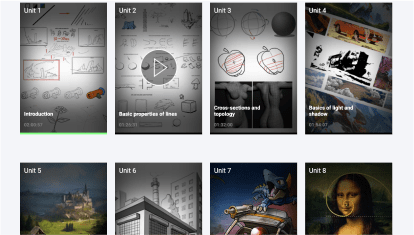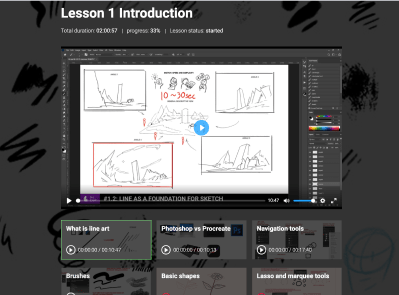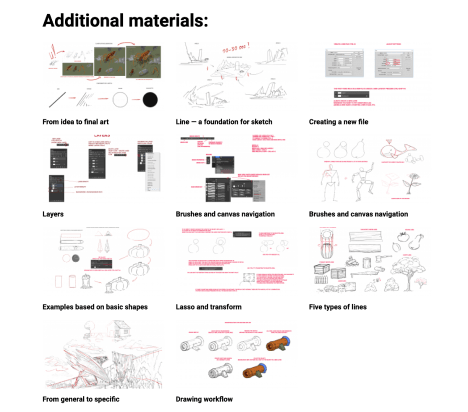

The course will be available right after payment.
During the course: it was difficult for Irene to practice because of her tight work schedule. Her dream of becoming an artist was saved by the "Time-Turner" course. Irene watched the lectures at her convenience, returning to past lessons whenever she needed a refresher.
After the course: Irene continued to develop her skills by studying anatomy, materials and character concept art. Eventually she was invited to work on an animation project as a 3D artist. It was then that she realized that she had found her calling in the CG industry.
During the course: Training was difficult; her brain stubbornly refused to work with her hands. The "Infinity Gauntlet" course made her life easier by structuring and gathering all the information she needed in one place. After that, nothing could distract from her main task: drawing.
After the course: Kate continued practicing, studying game graphics, character concept art, anatomy and even 3D software. She no longer had to spend time browsing the expanse of tutorials available online because it was faster, more efficient and more convenient to study on a single, specially tailored and ready-made program.
During the course: The "Master Yoda" course gave her confidence in her abilities. The course mentor invigorated her with new motivation every week, and taught her to find inspiration and draw from her imagination.
After the course: The initiative she built up during the course was enough to keep her skills growing and to elevate her drawing ability to a professional level. Ann sent her portfolio to a number of studios until she got the job she was aiming for.
During the course: Victor spared no effort in doing his homework and practicing regularly. The "Red Pill" course helped establish that drawing is a skill that everyone can enhance.
After the course: Having started the course with the interest of learning a new skill to use in his teaching, Victor now feels more comfortable in his abilities as an artist and has been able to use the principles he learned to create an animated series of English lessons for kids.
During the course: He enjoyed diving into this new world and hoped to find his calling in it. The "Jack Sparrow's Compass" course helped him determine his ultimate goal, and the course mentor guided him on how to reach it faster.
After the course: Den realized that he wanted to tell stories accompanied by colorful illustrations. He continued to practice drawing and learned more about storytelling in order to publish a book of his own illustrations.
During the course: She studied hard until she ran into some problems with Photoshop. It would have been impossible for her to continue if it wasn't for the support she got from the "All-Seeing Eye" course. Jane contacted technical support, who helped her resolve the problems in no time.
After the course: From there, Jane’s work rose to a whole new level. She learned to create handwritten fonts and graphic elements not found in stock images. Jane realized that she could also get feedback on technical problems in an online course, so she later went on to enroll in a motion design course.
Stop burying your talent! Finally, learn the Procreate and Photoshop interfaces, gain a powerful art base, and implement your ideas on the virtual canvas.













✓ 8 online group meetings with the mentor (totaling 18+ hours)
✓ individual homework review
✓ mentorship during the completion of your graduation project
✓ special offers on future courses
✓ сertificate of course completion
✓ personal manager and one-on-one support
✓ personal manager and one-on-one support
✓ 8 online group meetings with the mentor, totaling 18+ hours
✓ individual homework review
✓ mentorship during the completion of your graduation project


— this Course is the best gift for
beginning artists!
in advance and get the motivation
to start learning digitally.

♦ Work with home tasks, the main aspects of training
♦ Lines as the main tool of an artist
♦ Analysis of additional tools of the program interface
♦ First objects, the plane, and volume
♦ Primitive-based drawing, basic shape usage
♦ Auxiliary volume drawing and kinematic schemes
♦ Basic drawing principles (from general to more particular)

♦ Work with dynamic lines and strokes
♦ Line change depending on lighting, the depiction of light and shadow
♦ Physically correct parameters when drawing objects: connection to plane, the mass of objects
♦ Depiction of contrast by line, glare, refraction angles, reflections, and bends
♦ Depiction of object texture, drawing patterns, and repeating objects
♦ Line depth, the use of lines to determine objects' distance from the viewer

♦ The concept of an object’s shape and volume
♦ The study of object sections, simple and complex shapes
♦ Volume display using the studied line properties
♦ Determination of normals on an object's surface, the concept of the basic plane
♦ An object's sections according to given normals
♦ Cutting and combining parts of various objects, slices, secant planes, and incremental volumes
♦ The principles of displaying guides and dynamic lines on the surface of an object

♦ The structure of light and shadow in objects. The main features and patterns in work with chiaroscuro.
♦ Ambient light, directional light
♦ Construction of simple and complex shadows using the beam method
♦ Building a quality shadow from a complex object, learning to draw fake shadows
♦ The concept of general lighting for all objects in a figure

♦ Color and light in the work of a digital artist, physical and digital parameters
♦ Itten's color circle, blending, and color separation
♦ Basic methods of working with color
♦ Using contrasts of brightness, color, saturation
♦ Warm and cool color tones, and how to use them
♦ Recommendations for working with color and their range
♦ Color schemes and harmonies

♦ One-point perspective
♦ "Point-to-point perspective", architecture and design
♦ "Three-point perspective" as a tool for non-standard and complex angles
♦ "Aerial perspective", levels and location plans of objects
♦ Working with lines and color in perspective
♦ "Open space perspective": landscapes, architecture
♦ "The enclosed space perspective": design, interiors
♦ "Frontal perspective" and scale
♦ Working with light and shadow in perspective
♦ Construction of complex objects in perspective
♦ Setting the view (camera) in perspective

♦ The concept of composition, proportions, and ratio
♦ Formal composition
♦ The "golden ratio" rule, "rule of thirds"
♦ Transfer of feelings and emotions through composition
♦ The basic set of compositional solutions for the artist’s works

♦ The sequence of work with a picture, methods, and options
♦ Life hacks for the proper organization of work
♦ Practical examples of certain techniques
♦ Working with views, angles, camera
♦ Angle, mood and composition — creating a story in a picture
♦ Creating fast sketches, quick solutions — 80% of the results in 20% of the time
♦ Lines as the main tool of an artist
♦ Analysis of additional tools of the program interface
♦ First objects, the plane, and volume
♦ Primitive-based drawing, basic shape usage
♦ Auxiliary volume drawing and kinematic schemes
♦ Basic drawing principles (from general to more particular)
♦ Line change depending on lighting, the depiction of light and shadow
♦ Physically correct parameters when drawing objects: connection to plane, the mass of objects
♦ Depiction of contrast by line, glare, refraction angles, reflections, and bends
♦ Depiction of object texture, drawing patterns, and repeating objects
♦ Line depth, the use of lines to determine objects' distance from the viewer
♦ The study of object sections, simple and complex shapes
♦ Volume display using the studied line properties
♦ Determination of normals on an object's surface, the concept of the basic plane
♦ An object's sections according to given normals
♦ Cutting and combining parts of various objects, slices, secant planes, and incremental volumes
♦ The principles of displaying guides and dynamic lines on the surface of an object
♦ Ambient light, directional light
♦ Construction of simple and complex shadows using the beam method
♦ Building a quality shadow from a complex object, learning to draw fake shadows
♦ The concept of general lighting for all objects in a figure
♦ Itten's color circle, blending, and color separation
♦ Basic methods of working with color
♦ Using contrasts of brightness, color, saturation
♦ Warm and cool color tones, and how to use them
♦ Recommendations for working with color and their range
♦ Color schemes and harmonies
♦ "Point-to-point perspective", architecture and design
♦ "Three-point perspective" as a tool for non-standard and complex angles
♦ "Aerial perspective", levels and location plans of objects
♦ Working with lines and color in perspective
♦ "Open space perspective": landscapes, architecture
♦ "The enclosed space perspective": design, interiors
♦ "Frontal perspective" and scale
♦ Working with light and shadow in perspective
♦ Construction of complex objects in perspective
♦ Setting the view (camera) in perspective
● life hacks for the proper organization of work
● examples of certain techniques use in practice
● work with views, angles, camera
● angle, mood and composition—creating a story in a picture
● creating fast sketches, quick solutions—80% of the result in 20% of the time
♦ Formal composition
♦ The "golden ratio" rule, "rule of thirds"
♦ Transfer of feelings and emotions through composition
♦ The basic set of compositional solutions for the artist’s works



United Kingdom, G2 4JR
— All rights reserved

